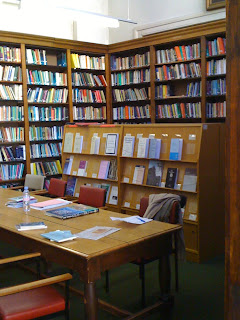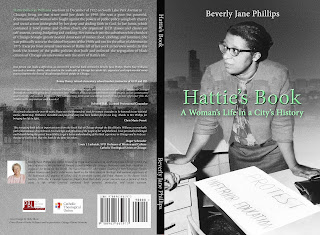A Theological Librarian's Trip to London--Part 1
(The first half of a blog post that was written as a guest post for my friend Anthony's blog, On Books and Biblios.)
What does a theological librarian and book lover do when spending a few days in London? Obviously, Charing Cross Road would be a good choice, but not this trip, so make a plan to see some interesting libraries AND find some astonishing places where books are hiding out! As a Catholic theological librarian, I was interested in seeing three Catholic libraries in or near London—the library at Heythrop College, the library at Allen Hall, and the Catholic National Library. As I am hoping to soon publish an article on these libraries and their collections, I will just mention how these fit on my tour. Heythrop College, the specialist philosophy and theological school of the University of London is just off Kensington High Street on Kensington Square. It started life in the 1600s as a Jesuit school and has moved several times due to Jesuit suppressions. Its fascinating history can be found here. After getting great pastry and cappuccino at a wonderful French patisserie just down the block, I went to meet Fr. Chris Pedley, SJ who gave me an informative tour, showing me several incunabula that were rescued from the wharf during one move a few hundred years ago!
What does a theological librarian and book lover do when spending a few days in London? Obviously, Charing Cross Road would be a good choice, but not this trip, so make a plan to see some interesting libraries AND find some astonishing places where books are hiding out! As a Catholic theological librarian, I was interested in seeing three Catholic libraries in or near London—the library at Heythrop College, the library at Allen Hall, and the Catholic National Library. As I am hoping to soon publish an article on these libraries and their collections, I will just mention how these fit on my tour. Heythrop College, the specialist philosophy and theological school of the University of London is just off Kensington High Street on Kensington Square. It started life in the 1600s as a Jesuit school and has moved several times due to Jesuit suppressions. Its fascinating history can be found here. After getting great pastry and cappuccino at a wonderful French patisserie just down the block, I went to meet Fr. Chris Pedley, SJ who gave me an informative tour, showing me several incunabula that were rescued from the wharf during one move a few hundred years ago!
The next stop on my Catholic library tour was Allen Hall, the diocesan seminary of the Westminster diocese. I might have been transgressing, but as the custodian of a collection of Moreana (books by and about St. Thomas More), the library at Allen Hall was a must-see.

In Chelsea, it is in the home where St. Thomas More lived with his family when he arrested prior to his beheading. The library has a small collection of St. Thomas More art, including this roundel of him and St. John Fisher.
The third library I visited was outside London, about a forty minute pleasant train ride, to Farnborough, the home of the Catholic National Library. What an enjoyable visit! The folks there gave me such a welcome though they had just gotten my email about visiting that very morning. The CNL is a populist lending library and the all-volunteer staff answer queries by email and send off books to people throughout the UK upon request. They, too, have a nice collection of Moreana and what seemed to be a pretty good collection of English recusant literature, along with a collection of Catholic fiction (seeing that and needing space has provided the impetus for me to do a bit of weeding in our collection to make our Catholic fiction collection just that and not a mishmash of classics that all well-read persons have on their personal shelves). They also have Mission Registers, which list baptisms, confirmations, marriages, deaths etc. dating back as early as 1694. These are heavily used for genealogy which accounts for much of their reference work. A fascinating thing about this library is that it has recently moved to St. Michael’s Abbey, which has its own very interesting history. It was founded by Empress Eugenie as an abbey and Imperial Mausoleum. She was crushed by the deaths of Napoleon III and their son, and on the site is the crypt of the royal family. It is a beautiful abbey with about five monks now working the abbey land.





Comments
Post a Comment